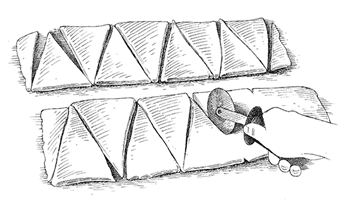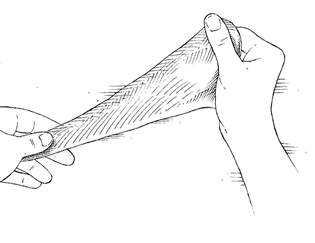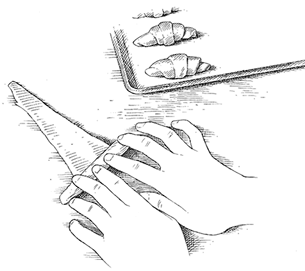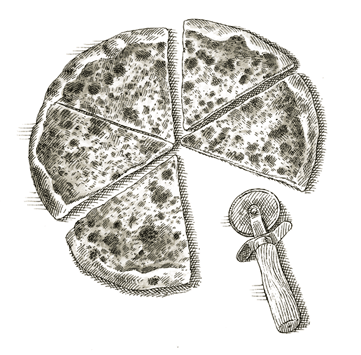The Cook's Illustrated Cookbook (280 page)
Read The Cook's Illustrated Cookbook Online
Authors: The Editors at America's Test Kitchen
Tags: #Cooking

![]() WHY THIS RECIPE WORKS
WHY THIS RECIPE WORKS
Crescent rolls from the supermarket are artificial tasting and stale quickly, but making them at home is time-consuming. We were determined to come up with a recipe for rich, tender, flaky crescent rolls that could fit into an already-hectic holiday cooking schedule. We found that skim milk added flavor without density, and melted butter and extra eggs enriched the dough. An overnight chill made the finished rolls crisp and flaky, and the resilient dough could be shaped and refrigerated for 3 days (or parbaked and frozen for 1 month), then baked right before serving, for rich, buttery rolls without any fuss.
See “SHAPING CRESCENT ROLLS” illustrations that follow recipe.
MAKES 16 ROLLS
We developed this recipe using lower-protein flour such as Gold Medal or Pillsbury. If using a higher-protein flour such as King Arthur, reduce the flour amount to 3¹⁄
2
cups (17¹⁄
2
ounces). If you don’t have a stand mixer, you can mix the dough by hand following the instructions in
“TEST KITCHEN TIP NO. 119 HAND-MIXING METHOD FOR DOUGH”
.
³⁄ | cup skim milk |
16 | tablespoons unsalted butter, cut into 16 pieces |
¹⁄ | cup (1³⁄ |
3 | large eggs |
4 | cups (20 ounces) all-purpose flour |
1 | teaspoon instant or rapid-rise yeast |
1¹⁄ | teaspoons salt |
1 | large egg white, beaten with 1 teaspoon water |
1.
Microwave milk, butter, and sugar in 4-cup liquid measuring cup until butter is mostly melted and mixture is warm (110 degrees), about 1¹⁄
2
minutes. Whisk to dissolve butter and blend in sugar. Beat eggs lightly in medium bowl; add about one-third of warm milk mixture, whisking to combine. When bottom of bowl feels warm, add remaining milk mixture, whisking to combine.
2.
Using stand mixer fitted with paddle, mix flour and yeast together on low speed until combined, about 15 seconds. Add egg mixture in steady stream and mix until loose, shiny dough forms (you may also see satiny webs as dough moves in bowl), about 1 minute. Increase speed to medium and beat for 1 minute; add salt slowly and continue beating until stronger webs form, about 3 minutes longer. (Dough will remain loose rather than forming neat, cohesive mass.) Transfer dough to large, lightly greased bowl; cover tightly with plastic wrap and let rise at room temperature until dough doubles in size and surface feels tacky, about 3 hours.
3.
Line rimmed baking sheet with plastic. Sprinkle dough with flour (no more than 2 tablespoons) to prevent sticking, and press down gently to deflate. Transfer dough to floured counter and press into rough rectangle shape. Transfer rectangle to prepared baking sheet, cover with plastic, and refrigerate for 8 to 12 hours.
4.
Transfer dough rectangle to lightly floured counter and line baking sheet with parchment paper. Roll dough into uniform 20 by 13-inch rectangle. Cut dough in half lengthwise, then cut each rectangle into 8 triangles, trimming edges as needed to make uniform triangles. Before rolling crescents, elongate each triangle of dough, stretching it an additional 2 to 3 inches in length. Starting at wide end, gently roll up dough, ending with pointed tip on bottom, and push ends toward each other to form crescent shape. Arrange crescents in 4 rows on prepared baking sheet; wrap baking sheet with plastic, and refrigerate for at least 2 hours or up to 3 days.
5.
Remove baking sheet with chilled rolls from refrigerator, unwrap, and slide baking sheet into large clean garbage bag; seal to close. Let crescents rise until they feel slightly tacky and soft and have lost their chill, 45 minutes to 1 hour.
6.
Thirty minutes before baking, adjust oven racks to lower-middle and lowest positions, place second rimmed baking sheet on lower rack, and heat oven to 425 degrees. Bring 1 cup water to boil on stovetop. Lightly brush risen crescent rolls with egg white mixture. Working quickly, place baking sheet with rolls on upper rack, then pour boiling water onto rimmed baking sheet on lower rack and quickly close oven door. Bake for 10 minutes, then reduce oven temperature to 350 degrees and continue baking until tops and bottoms of rolls are deep golden brown, 12 to 16 minutes longer. Transfer rolls to wire rack, let cool for 5 minutes, and serve warm. (Rolls can be placed in zipper-lock bag and stored at room temperature for up to 3 days. Wrapped with aluminum foil before placing in bag, rolls can be frozen for up to 1 month.)
TO MAKE AHEAD:
Rolls can be partially baked and frozen until ready to serve. Begin baking rolls as instructed, but let them bake at 350 degrees for only 4 minutes, or until tops and bottoms brown slightly. Remove them from oven and let cool to room temperature. Place partially baked rolls in single layer inside zipper-lock bag and freeze. When ready to serve, defrost rolls at room temperature and place in preheated 350-degree oven for 12 to 16 minutes.

1.
Roll dough into 20 by 13-inch rectangle. Using pizza wheel or sharp knife, cut dough in half lengthwise, then cut 16 triangles, trimming edges as needed to make uniform triangles.

2.
Elongate each triangle of dough, stretching it an additional 2 to 3 inches in length.

3.
Gently roll up each crescent, ending with pointed tip on bottom, and push ends toward each other to form crescent shape.

![]() WHY THIS RECIPE WORKS
WHY THIS RECIPE WORKS
While we all settle for convenience over quality on occasion, the difference between a takeout or frozen pizza and homemade is extreme. Homemade pizza really is superb, but the tomato sauce and dough are time-consuming. We set out to shortcut those steps for homemade pizza that could practically be made in the time it takes to heat the oven. For the crispiest crust, we liked using a pizza stone. We also found that a fast tomato sauce, enlivened with olive oil and garlic tasted just as good as a long-cooked tomato sauce. As for the toppings, we took a cue from high-end pizzerias and in addition to classic sausage and bell pepper, we combined mushrooms, fontina, and sage in one variation, and prosciutto and arugula in another.
MAKES 2 POUNDS DOUGH, ENOUGH FOR TWO 14-INCH PIZZAS
All-purpose flour can be substituted for the bread flour, but the resulting crust will be a little less chewy.
4–4¹⁄ | cups (22 to 23¹⁄ |
2¹⁄ | teaspoons instant or rapid-rise yeast |
1¹⁄ | teaspoons salt |
2 | tablespoons olive oil |
1¹⁄ | cups water, heated to 110 degrees |
1.
Pulse 4 cups flour, yeast, and salt together in food processor (fitted with dough blade if possible) until combined, about 5 pulses. With food processor running, slowly add oil, then water; process until rough ball forms, 30 to 40 seconds. Let dough rest for 2 minutes, then process for 30 seconds longer. (If, after 30 seconds dough is sticky and clings to blade, add remaining ¹⁄
4
cup flour 1 tablespoon at a time as needed.)
2.
Transfer dough to lightly floured counter and knead by hand into smooth, round ball. Place dough in a large, lightly greased bowl; cover bowl tightly with greased plastic wrap and let rise at room temperature until doubled in size, 1 to 1¹⁄
2
hours, before using.